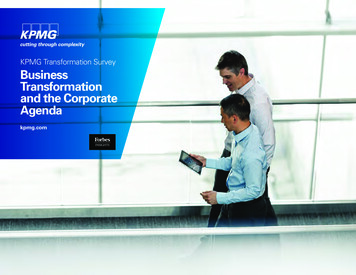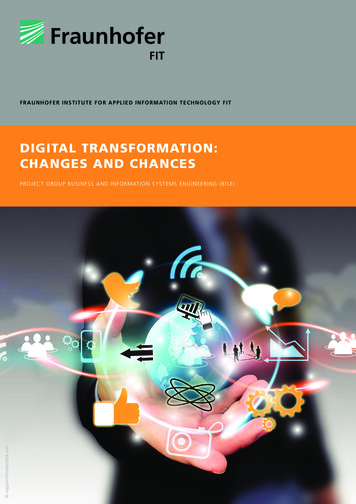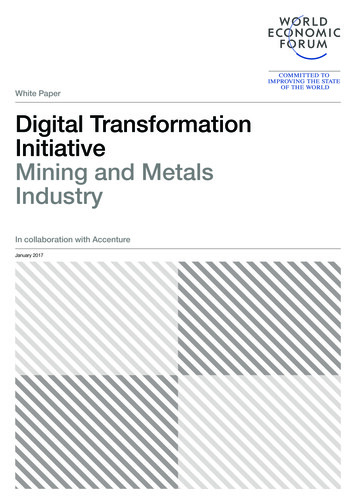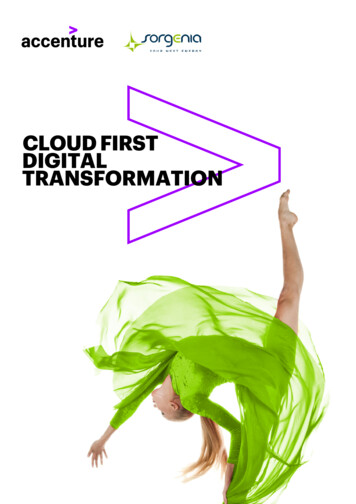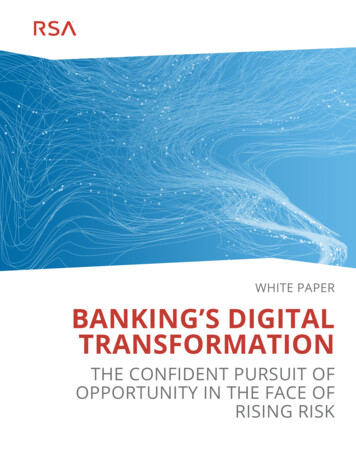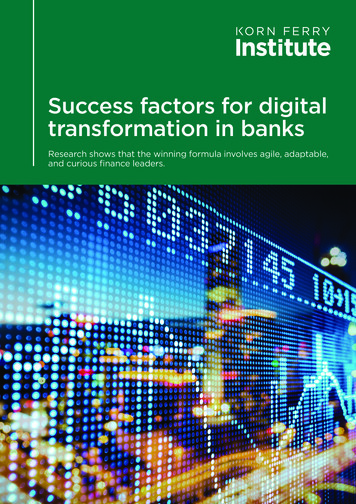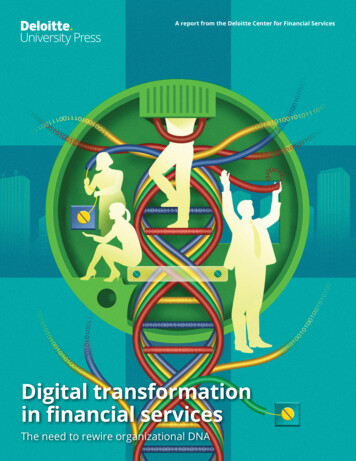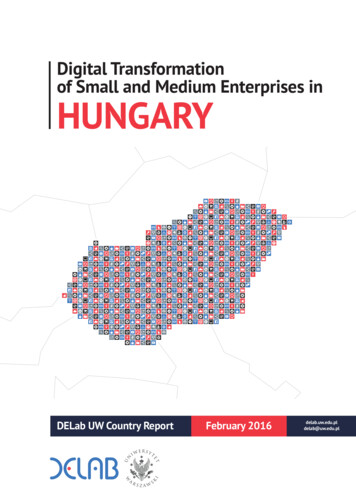
Transcription
Digital Transformationof Small and Medium Enterprises inHUNGARYDELab UW Country ReportFebruary 2016delab.uw.edu.pldelab@uw.edu.pl
dr hab. Katarzyna Śledziewskadr Renata WłochTinatin AkhvledianiKristóf GyódiDamian ZiębaEditor:Martyna OlivetAcknowledgements:dr Agnieszka PugacewiczMichał ZiembińskiDesign: EMLABCommissioned by Google DELab UW March 20162
DELab UW 2016delab.uw.edu.pl delab@uw.edu.plTable of ContentsAbout DELab . 4Acronyms . 5Main Concepts . 6Key Findings . 8Executive Summary . 9Digital Map: Hungary among the EU28 . 10Digital Business Environment for SMEs . 13 Digital Skills in SMEs . 14 Digital Infrastructure . 19Digital Technologies . 21 Websites and Social Media . 22 E-commerce . 25 Management Tools . 27 Cloud Computing . 28Conclusions . 30Recommendations . 303
About DELabDigital Economy Lab (DELab) is a research centre established in 2014 within the University ofWarsaw to accelerate the development of digital economy and society by providing high-qualityresearch on the impacts of digital transformation and innovation. By application of data sciencemethods DELab examines how digital markets, skills and societies build smart economies,businesses and governance. We deliver policy recommendations on how to better meet thechallenges of global digitalisation. Our studies promote entrepreneurship and enhance society’s awareness of the benefits of digital transformation. DELab’s interdisciplinary team consistsof professors and young researchers from various academic backgrounds including economics,sociology, law, administration, IT, European integration, philosophy, political sciences, globalisation, management and entrepreneurship.4
DELab UW 2016delab.uw.edu.pl delab@uw.edu.plAcronymsB2B–B2C–B2G–CRM –DESI –ERP–EU15 –EU28 –ICT–Mbps –NMS13 –SCM–SMEs –Business to BusinessBusiness to CustomerBusiness to GovernmentCustomer Relationship ManagementDigital Economy and Society IndexEnterprise Resource PlanningAustria, Belgium, Denmark, Finland, France, Germany, Greece, Ireland, Italy,Luxembourg, Netherlands, Portugal, Spain, Sweden, United Kingdomall EU member statesInformation Communications TechnologiesMegabits (Mb) per secondBulgaria, Croatia, Cyprus, Czech Republic, Estonia, Hungary, Latvia, Lithuania, Malta,Poland, Romania, Slovak Republic, SloveniaSupply Chain ManagementSmall and Medium- sized Enterprises5
Main ConceptsDigital transformation of enterprisesChanges in the functioning of enterprises due to the adjustments in businessenvironment associated with the new application of digital technologiesDigital business environmentThe digital skills of human capital and the development of digitalinfrastructure enabling utilization of digital technologiesDigital skills of human capitalAdoption and skillful utilization of digital technologiesby human capitalDigital infrastructureStructure needed for adoption and utilization of digital technologies;facilities to interconnect components of digital business environmentDigital technologiesElectronic tools, systems, devices and resources that generate, storeor process data: websites, social media, e-commerce, management tools,cloud computing6
DELab UW 2016delab.uw.edu.pl delab@uw.edu.plDigitalTransformationDigital BusinessEnvironmentDigital Skills ofHuman sites andSocial MediaE-commerceManagment ToolsCloud ComputingDigital transformation enables and accelerates the smart integration of products and servicesinto the economy and society. Its strongest effect lies in the optimal combination of digitaltechnologies with digital business environment.The more developed the digital infrastructure and digital skills within a society, the better theutilisation of digital technologies. Similarly, the higher the utilisation of digital technologies,the higher the demand for human capital to employ and upgrade digital inventions. Digitaltools enable smart economic integration of production and delivery of products and servicesto customers. Digitally aware SMEs find new market opportunities with greater ease, growtheir business partner networks faster and obtain quality feedback from their clients throughcustomer relation management tools.7
Key FindingsHungary in the EU28 1st in Social Network usage by individuals 12th in the Use of Internet 17th in Connectivity 17th in Human Capital 25th in Digital Public Services 26th in Integration of Digital TechnologySMEs in Hungary Have access to digitally skilled workforce 8Have not taken up digital technologies, especially cloud computing services and electronic information sharing toolsDo not invest in upgrading ICT related skills of employeesHave access to poor digital infrastructure (lack of high-speed andaffordable Internet)
DELab UW 2016delab.uw.edu.pl delab@uw.edu.plExecutive SummaryIn this report we examine the level of digital transformation of SMEs in Hungary in comparison to SMEs from other EU countries. We take into consideration both the digital businessenvironment (digital infrastructure such as Internet availability and digital skills of humancapital) and the adoption of digital technologies. The introduction of digital technologies suchas websites, social media, e-commerce, electronic information sharing and cloud computingsimplifies and accelerates decision making, allows effective brand building, facilitates transactions and makes it possible to reach new customers.Why is it so important for SMEs to go digital?Internet and digital tools become a must in the context of the Digital Single Market strategy.The regulations proposed within the DSM greatly enhance the opportunities stemming fromsuccessful digital transformation, as well as pose risks connected with losing markets and customers due to digital business illiteracy. Although the digital revolution affects both ICT andtraditional businesses, it puts significant pressure on Small and Medium Enterprises (SMEs)that are relatively more sensitive to global competition occurring within the Internet compared to their stronger, bigger counterparts.Are Hungarian SMEs ready to compete on the Digital Single Market?Our analysis may suggest that they are in dire need of a digital makeover. Most of the Hungarian SMEs make no use of e-commerce tools, cloud computing services and electronic information sharing tools. The poor digital infrastructure is another burden. But the most strikingfinding is that Hungarians seem to forget the digital proficiency that they possess and use athome once they enter their workplaces. Hungary ranks first among the EU28 in social media usage by individuals, but only a very small share of SMEs employ social media servicesto communicate with their customers. The employers also see no need to invest in digitaltrainings for their workforce. As a result, according to the indicators measuring digital transformation of economy and society (DESI), the country takes one of the last places among theEU28 and falls behind other NMS.9
Digital Map: Hungary in the EU28“Digital Economy and Society Index” (DESI) measures the degree of digitaltransformation of the EU member states. Namely, the index reports the levelof development in the foll wing categories: access, speed and quality of Internet infrastructure (represented by “Connectivity”), digital skills of society(“Human Capital” and “Use of Internet”), digitization of businesses (“Integration of Digital Technology”) and public e- services.According to the DESI Index, Hungary takes the 20th place in the EU, revealing considerablegaps with respect to other countries in several dimensions. Regarding Connectivity (whichmeasures the deployment of broadband infrastructure and its quality), Hungary ranks 17th,slightly below the EU average. Fixed broadband services are available for 95% of households(EU average is 97%), while fast broadband covers 78% of homes, above the EU average of 71% 3.3Source: Eurostat10
DELab UW 2016delab.uw.edu.pl delab@uw.edu.plHuman Capital indicates the level of digital skills of a society. Hungarians, ranking 17th, perform better than the NMS average. Additionally, Hungarian Internet users are outperformingthe EU28 average in the engagement of numerous online services (12th rank in the Use of Internet dimension). Hungarians are the number one users of social networks, frequently engage in video calls (5th rank) and read the news online (7th rank). However, the share of onlineshoppers and users of online banking is relatively low (20th position in both). The development of Digital Public Services (like e- government) is also at a low level (25th place).28. Romania27. Bulgaria26. Greece20. Hungary28. Romania27. Bulgaria26. Greece3. Sweden20. Hungary2. Netherlands1. Denmark3. Sweden2. Netherlands0102030405060Figure 1 DESI Index, 2016Digital Public ServicesIntegration of Digital TechnologyUse of InternetHuman CapitalConnectivityDigital Public ServicesIntegration of Digital TechnologyUse of InternetSource: Digital Agenda for Europe, DESI.Human CapitalConnectivity11
Integration of Digital Technology presents the level of Digital Transformation achieved byenterprises (with more than 10 employees). It is measured by the adoption of digital tools, likecloud computing services, and the engagement in e- commerce.30405060The gap in digitalisation between Hungary and the EU28 average is the most significant inthe business sector. Hungary is only the 26th which shows that Hungarian enterprises do nottake full advantage of the digital tools. The share of Hungarian enterprises using electronicinformation sharing (i.e. management tools), like ERP software (27th), cloud computing services (23rd) or social media (22nd) is one of the lowest in the EU. Hungarian enterprises are notengaged in e-commerce (20th in the share of firms; 21st in turnover share, 23rd in cross-border selling).3020Electronic Information Sharing10RFIDE-invoicesSocial MediaCloudSource: Digital Agenda forRFIDEurope, DESI.Electronic Information Sharing12Social MediaE-invoices28. Romania27. Latvia26. Hungary3. Sweden2. Denmark1. Ireland0E-commerce28. Romania27. Latvia26. Hungary3. Sweden2. Denmark40501. Ireland0601020Figure 2 Integration of Digital Technology, 2016
DELab UW 2016delab.uw.edu.pl delab@uw.edu.plDigital Business Environment for SMEsDigital Business Environment creates the commonframework that enables SMEs to utilise digital technologyand facilitates engagement of SMEs in the digital economy.We assess Digital Business Environment by analysing the development of digital skills and digital infrastructure. More precisely, we consider the efforts of companies in hiring and trainingdigitally skilled people (also, but not exclusively ICT specialists) and we assess digital infrastructure by the access, affordability, speed and quality of the Internet.13
Digital SkillsWhen it comes to digital skills, Hungarians perform slightly better than other NMS citizens:the share of Hungarians with “basic” digital skills (30%) is above the NMS average (26%);and Hungarians slightly less often report “low” digital skills (26%), than the regional average(27%). When it comes to communication, the majority of individuals report “above basic” skills(70%), same goes for information skills (66%). However, they are less at ease when it comes toproblem solving and software skills, where they tend to fall below the EU15 average.Figure 3 Levels of digital skills amongst individuals (%), GARYAbove basic skills refer to the ability to carry out most of the tasks in all of four general on, Information, Problem solving and Software)Basic skills refer to the ability to carry out one specific task in each categoryLow skills refer to users who are unable to perform any tasks in up to 3 categoriesNo skills refer to users who are unable to perform any tasks in all categories listed including those who havenot accessed the Internet in the last 3 monthsSource: DELab UW own calculations based on the data from Eurostat14
DELab UW 2016delab.uw.edu.pl delab@uw.edu.plFigure 4 Individuals with “above basic” digital skills(%), EU15NMS13HUNGARYNMS13HUNGARY61%Problem ion skills include the ability to communicate online via e- mail, video calls or the social mediaInformation skills show the ability to find relevant information onlineProblem solving skills represent the ability to manage files, change settings of software and use online servicesSoftware skills include the ability to use word processing, spreadsheet and multimedia editing softwareSource: DELab UW own calculations based on the data from Eurostat15
Unsurprisingly, analysis of students’ skills indicates that relative to other individuals, studentsreport more advanced digital skills. Namely, around 95% of students are equipped with “abovebasic” communication skills and around 90% with “above basic” information skills. However,when it comes to problem solving and software skills, Hungarian students slightly fall belowthe average level in the EU15 (74 to 82% in problem solving, and 74 to 84% in software).Figure 5 Students with selected levels of digital skills (%), 13HUNGARY8%9%7%Source: DELab UW own calculations based on the data from YHUNGARYHUNGARYHUNGARY
DELab UW 2016delab.uw.edu.pl delab@uw.edu.plFigure 6 Students with “above basic” of digital skills (%), 2%Problem NGARYHUNGARYHUNGARYSource: DELab UW own calculations based on the data from Eurostat17
But the most crucial impediment is the attitude of the Hungarian SMEs that seem to ignorethe benefits of digital skills among all employees. Admittedly, they employ a high share of ICTspecialists but are not interested to upgrade ICT related skills of their employees, e.g. twiceless often invest in ICT trainings.Overall, SMEs in Hungary show a high demand for ICT specialists: on average, they employmore ICT specialists than enterprises in the EU15. However, the share of enterprises that provide trainings for their ICT specialists is below the NMS13 level. Moreover, the share of SMEsinvesting in ICT trainings for their other employees is also well below the regional averagelevel (11% to 13% in the NMS and 21% in the EU15).Figure 7 SMEs employing and training ICT specialists (%), UNGARYHUNGARYHUNGARYRecruited / tried to recruitICT specialistsSource: DELab UW own calculations based on the data from Eurostat18NMS13HUNGARYProvided trainingto ICT specialistsEmployed ICT rovided trainingto other employeesHUNGARY
DELab UW 2016delab.uw.edu.pl delab@uw.edu.plDigital InfrastructureThe access to high-speed and good quality Internet should be the cornerstone of digitalinfrastructure. Here, the situation of the Hungarian small and medium enterprises negativelystands out in comparison with SMEs in EU15: one in ten lacks access to the Internet, while inthe EU15 only two in one hundred.Hungarian SMEs mainly use low (35%) and middle- speed (29%) Internet. Moreover, while inthe EU15, on average, every third SME has access to 2,31high- speed Internet, in Hungary onlyevery fifth enterprise benefits from it. Hungarian enterpriseslag behind in fixed broadband5,32subscriptions (84% against the EU15 average of 94%),9,76as well as mobile Internet subscriptions(63% against 71%).Figure 8 SMEs with no Internet access (%), 2015EU152%5%NMS13HUNGARY10%Figure 9 SMEs according to the speed of their Internetconnection (%), GARYHUNGARYHUNGARYHUNGARYSource: DELab UW own calculations based on the data from Eurostat19
The significantly higher cost of Internet access may explain the relatively low take-up ofhigh-speed Internet connections: Hungary is the fifth most expensive EU country in terms ofmedian Internet prices. While in the EU15, median price of monthly subscription is 37 euros, inHungary it reaches 52 euros.Figure 10 Median price of monthly subscription to the Internet(30-100 Mbps) in euros/PPP, 201510 to 2020 to 3030 to 4040 to 5050 to 6060 to 7070 to 80missingSource: DELab UW own calculations based on the data from Eurostat20
DELab UW 2016delab.uw.edu.pl delab@uw.edu.plDigital TechnologiesThe usage of digital technologies simplifies and accelerates decision making processes withinthe enterprise; allows more effective business analyses; facilitates the communication withbusiness partners; allows effective image and brand building; and supports the penetration ofnew markets as well as reaching new customers. To measure the adoption of digital tools weconsider the usage of five key technologies: websites, social media, e- commerce, managementtools (like ERP) and cloud computing.Although the development
shoppers and users of online banking is relatively low (20th position in both). The develop-ment of Digital Public Services (like e-government) is also at a low level (25th place). Source: Digital Agenda for Europe, DESI. Figure 1 DESI Index, 2016 Integration of Digital Technology Digital P
